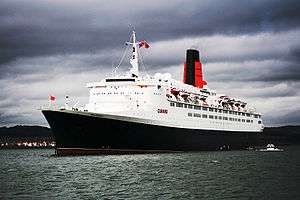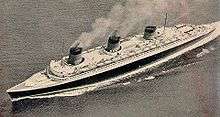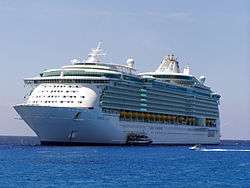Passenger ship

A passenger ship is a merchant ship whose primary function is to carry passengers. The category does not include cargo vessels which have accommodations for limited numbers of passengers, such as the ubiquitous twelve-passenger freighters once common on the seas in which the transport of passengers is secondary to the carriage of freight. The type does however include many classes of ships designed to transport substantial numbers of passengers as well as freight. Indeed, until recently virtually all ocean liners were able to transport mail, package freight and express, and other cargo in addition to passenger luggage, and were equipped with cargo holds and derricks, kingposts, or other cargo-handling gear for that purpose. Only in more recent ocean liners and in virtually all cruise ships has this cargo capacity been eliminated.
While typically passenger ships are part of the merchant marine, passenger ships have also been used as troopships and often are commissioned as naval ships when used as for that purpose.
Types


Passenger ships include ferries, which are vessels for day or overnight short-sea trips moving passengers and vehicles (whether road or rail); ocean liners, which typically are passenger or passenger-cargo vessels transporting passengers and often cargo on longer line voyages; and cruise ships, which often transport passengers on round-trips, in which the trip itself and the attractions of the ship and ports visited are the principal draw.
An ocean liner is the traditional form of passenger ship. Once such liners operated on scheduled line voyages to all inhabited parts of the world. With the advent of airliners transporting passengers and specialized cargo vessels hauling freight, line voyages have almost died out. But with their decline came an increase in sea trips for pleasure, and in the latter part of the 20th century ocean liners gave way to cruise ships as the predominant form of large passenger ship, with the main area of activity changing from the North Atlantic Ocean to the Caribbean Sea.
Although some ships have characteristics of both types, the design priorities of the two forms are different: ocean liners value speed and traditional luxury while cruise ships value amenities (swimming pools, theaters, ball rooms, casinos, sports facilities, etc.) rather than speed. These priorities produce different designs. In addition, ocean liners typically were built to cross the Atlantic Ocean between Europe and the United States or travel even further to South America or Asia while cruise ships typically serve shorter routes with more stops along coastlines or among various islands.
For a long time, cruise ships were smaller than the old ocean liners had been, but in the 1980s, this changed when Knut Kloster, the director of Norwegian Caribbean Lines, bought one of the biggest surviving liners, the SS France, and transformed her into a huge cruise ship, which he renamed the SS Norway. Her success demonstrated that there was a market for large cruise ships. Successive classes of ever-larger ships were ordered, until the Cunard liner Queen Elizabeth was finally dethroned from her 56-year reign as the largest passenger ship ever built (a dethronement that led to numerous further dethronements from the same position).
Both the RMS Queen Elizabeth 2 (QE2) (1969) and her successor as Cunard's flagship RMS Queen Mary 2 (QM2), which entered service in 2004, are of hybrid construction. Like transatlantic ocean liners, they are fast ships and strongly built to withstand the rigors of the North Atlantic in line voyage service,[1] but both ships are also designed to operate as cruise ships, with the amenities expected in that trade. QM2 was superseded by the Freedom of the Seas of the Royal Caribbean line as the largest passenger ship ever built; however, QM2 still hold the record for the largest ocean liner. The Freedom of the Seas was superseded by the Oasis of the Seas in October 2009.[2]
Measures of size



By convention and long usage, the size of civilian passenger ships is measured by gross tonnage, which is a dimensionless figure calculated from the total enclosed volume of the vessel. Gross tonnage is not a measure of weight, although the two concepts are often confused. Weight is measured by displacement, which is the conventional means of measuring naval vessels. Often a passenger ship is stated to "weigh" or "displace" a certain "tonnage", but the figure given nearly always refers to gross tonnage, which in this context has nothing to do with weight.
While a high displacement can indicate better sea keeping abilities,[3] gross tonnage is promoted as the most important measure of size for passengers, as the ratio of gross tonnage per passenger – the Passenger/Space Ratio – gives a sense of the spaciousness of a ship, an important consideration in cruise liners where the onboard amenities are of high importance.[4][5]
Gross tonnage normally is a much higher value than displacement. This was not always the case; as the functions, engineering and architecture of ships have changed, the gross tonnage figures of the largest passenger ships have risen substantially, while the displacements of such ships have not. RMS Titanic, with a gross register tonnage of 46,329 GRT, but a displacement reported at over 52,000 tons,[6] was heavier than contemporary 100,000 – 110,000 GT cruise ships which displace only around 50,000 tons. Similarly, the Cunard Line's RMS Queen Mary and RMS Queen Elizabeth, of approximately 81,000 – 83,000 GT, but displacements of over 80,000 tons,[7] do not differ significantly in displacement from their new 148,528 GT successor, RMS Queen Mary 2,[8][9] which has been estimated to displace approximately 76,000 tons[10][11] With the completion in 2009 of Oasis of the Seas, the first of the Oasis Class ships, the Cunard Queens of the 1930s have clearly been passed in displacement, as the Oasis vessels were projected to displace about 100,000 tons.[12]
However, by the conventional and historical measure of gross tonnage, there has been a recent dramatic increase in the size of the largest new ships. The Oasis of the Seas measures over 225,000 GT, over twice as large as the largest cruise ships of the late 1990s.
Safety regulations
Passenger ships are subject to two major International Maritime Organization requirements : to perform musters of the passengers (...) within 24 hours after their embarkation and to be able to perform full abandonment within a period of 30 minutes from the time the abandon-ship signal is given.[13]
Design considerations
Passengers on ships without backup generators suffer substantial distress due to lack of water, refrigeration, and sewage systems in the event of loss of the main engines or generators due to fire or other emergency. Power is also unavailable to the crew of the ship to operate electrically powered mechanisms. Lack of an adequate backup system to propel the ship can, in rough seas, render it dead in the water and result in loss of the ship.[14] The 2006 Revised Passenger Ship Safety Standards address these issues, and others, requiring that ships ordered after July, 2010 conform to safe return to port regulations; however, as of 2013 many ships remain in service which lack this capacity.[15]
After October 1, 2010, the International Convention for the Safety of Life at Sea (SOLAS) requires passenger ships operating in international waters must either be constructed or upgraded to exclude combustible materials. It is believed some owners and operators of ships built before 1980, which are required to upgrade or retire their vessels, will be unable to conform to the regulations.[15] Fred Olsen's Black Prince, built in 1966 was one such ship, but was reported to be headed for inter-island service in Venezuelan waters.[16]
External safety measures
The International Ice Patrol was formed in 1914 after the sinking of the RMS Titanic to address the long-outstanding issue of iceberg collision.
Notes
- ↑ "Winter 03-04: A Ship For The Sea". Cruise Industry News. Retrieved 2012-05-23.
- ↑ "Royal Caribbean orders .24B cruise ship - Boston.com". Archived from the original on 20 February 2009.
- ↑ "Internet Archive Wayback Machine" (PDF). Wayback.archive.org. Retrieved 2012-05-23.
- ↑ "Glossary, definition of Passenger Space Ratio". Information and Explanations. choosecruising.com. Retrieved 2007-12-28.
- ↑ "Cruise Ship Tonnage". 123Ttravel.com. Archived from the original on October 11, 2007. Retrieved 2007-12-28.
- ↑ Titanic's DimensionsTitanic's Dimensions Archived May 27, 2006, at the Wayback Machine.
- ↑ "Queen Mary Home". Atlanticliners.com. Retrieved 2012-05-23.
- ↑ United States Coast Guard Maritime Information Exchange, Queen Mary 2, Retrieved 2012-03-26
- ↑ "Queen Mary 2 (9241061)". Ships In Class. Lloyd's Register. Retrieved 2012-07-19. (subscription required (help)).
- ↑
- ↑
- ↑ If Royal Caribbean builds it, 6,400 could come, Boston Globe (February 7, 2006).
- ↑ "A ship is its 'own best lifeboat'". Lloyd's List Australia. 18 January 2012. Retrieved 20 January 2012.
- ↑ Barry Meier; John Schwartz (February 24, 2013). "Lack of Backup Power Puts Cruise Passengers at the Ocean's Mercy". The New York Times. Retrieved February 25, 2013.
- 1 2 "Hidden Depths of SOLAS" WorldCruise-Network.com 8 September 2010, accessed February 25, 2013
- ↑ Reinikainen, Kari (2009-05-06). "Fred. Olsen sells Black Prince for further trading". Cruise Business Online. Cruise Media Oy Ltd. Retrieved 2009-05-10.
References
- Durand, Jean-François. Autour du Monde Paquebots. Cruise ships around the world. Editions marines, 1996. [bilingual text]
- Marin, Pierre-Henri. Les paquebots, ambassadeurs des mers. Paris: Gallimard, 2011.
External links
| Wikimedia Commons has media related to Passenger ships. |